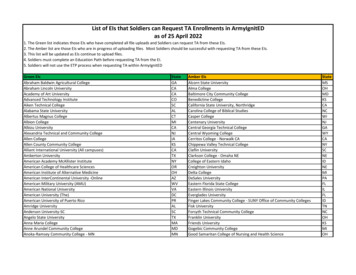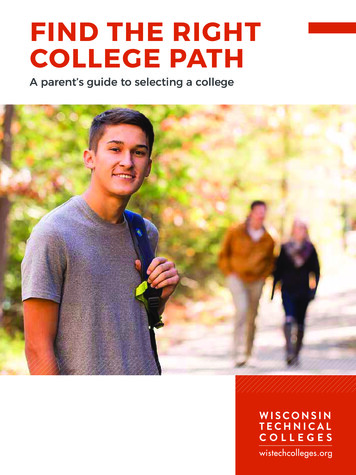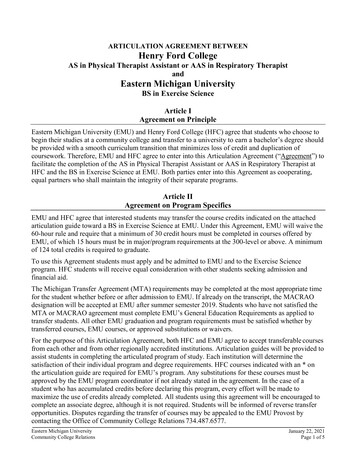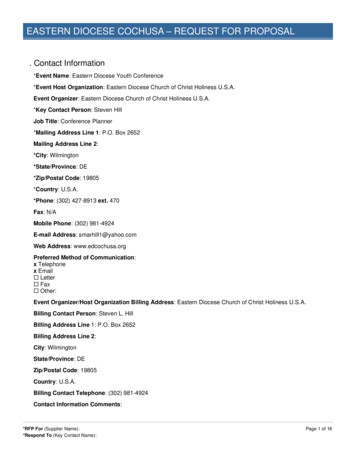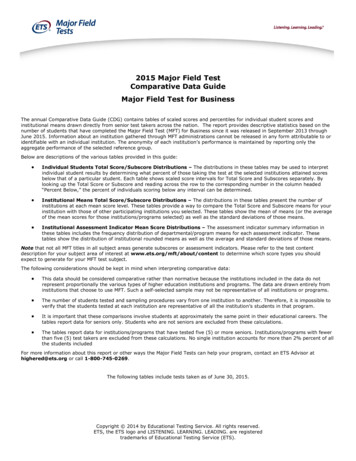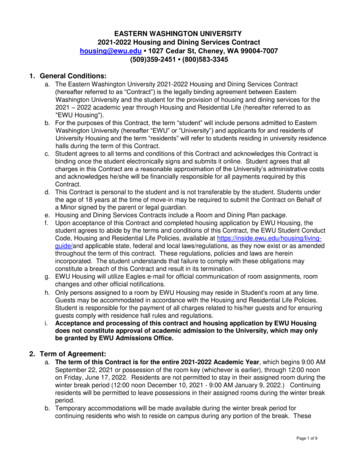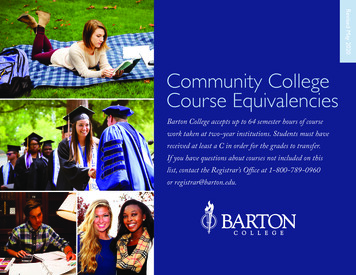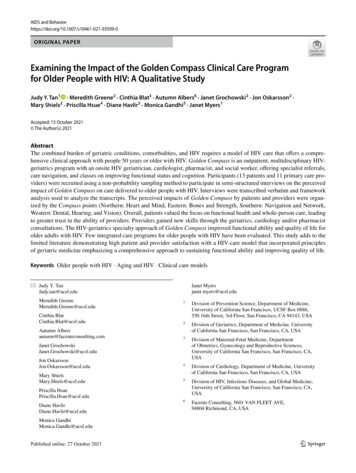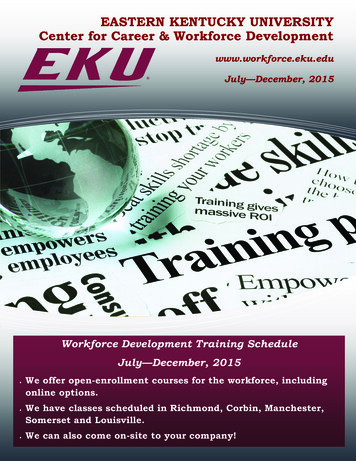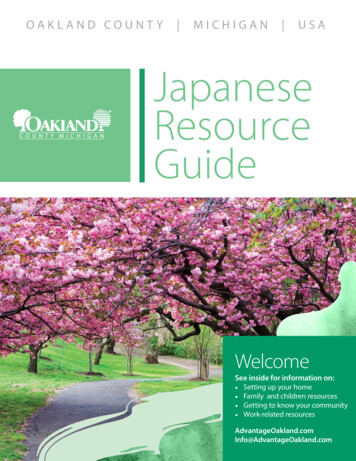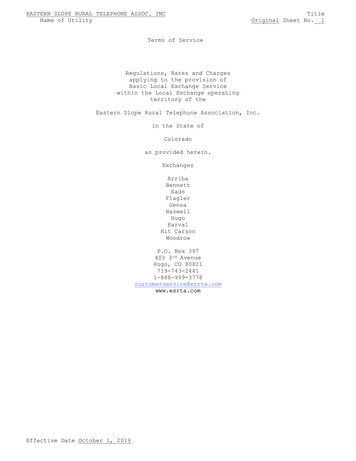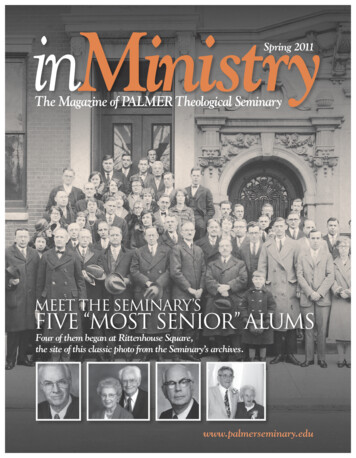
Transcription
inMinistrySpring 2011The Magazine of PALMER Theological SeminaryMeet The Seminary’sFIVE “MOST SENIOR” ALUMSFour of them began at Rittenhouse Square,the site of this classic photo from the Seminary’s archives.www.palmerseminary.edu
INSIDEinMinistryWill the WorldEnd on May 21?Palmer Seminary’sFive “Most Senior” Alums4Fodder for Pastors7From Ordinary to Sacred SpaceA Meditation fromProfessor Diane Chen8PTS StudentsTravel to Mexico10Book Notes11Community NewsRead up on what’shappening at Palmer andwith Seminary alums.12Weekly Commute:1,300 miles14A PTS Studentarrives each Tuesdayfrom Dallas.Dean’s Message15inMinistryinMinistry is published byPalmer Theological Seminary6 E. Lancaster AvenueWynnewood, PA 19096Phone: 610.896.5000www.palmerseminary.edu Palmer Theological SeminaryApril 2011. All rights reserved.Christopher A. HallDeanRandall L. FrameEditor, Executive Director ofMarketing and CommunicationsMelodee StephensDesigner2inMinistry Spring 2011EDITOR’SNOTEIhave worked on many issues of inMinistry overthe years, but none more interesting thanthis one. It was a privilege and a joy to have theopportunity to speak with some of our oldest alums(pp. 4-6), men who attended the Seminary when itwas still at its original location on Rittenhouse Square.This issue also features a student (p. 14), who, asfar as anyone around here can tell or recall, holds therecord for commuting (each week!) from the longestdistance: Dallas. Not Dallas, Pennsylvania, but Dallas, Texas.Then there is the delightful story of Victoria (Vica) Shaffer and KyleJones, who met at a new student orientation a couple of years ago. Vica willbe graduating with an MTS degree on Saturday morning, May 21, thengetting married to Kyle later that same day. I’m told by longtime Seminaryemployee Ruth McFarland that this is not a first in the Seminary’s history, butI’d venture to say it is the first time in our history that someone will graduateand get married on the same date that some Christians—as has been widelyreported—are predicting the end of the world.This brings me to the main point of this brief reflection. In recent decades,seminaries, including ours, have been careful to pay attention to students’spiritual and emotional growth, not just their intellectual development. Whileaffirming the validity of this trend, we should also be clear that the acquisitionof knowledge remains a critical component of the seminary experience. That’swhy we call it “theological education.”The church needs pastors who, instead of being tossed about by everywind of doctrine, will interpret the Bible responsibly, in ways that reflect theirknowledge of biblical languages, Old and New Testament culture, theology,church history, and more. Pastors are able to do this because of what theylearn at seminary.I’m proud to say that I’m not aware of any PTS student who is so smart andso clued in with God that they are claiming the world will end on May 21,2011. As for me, I’m overwhelmingly confident that this May 21 the weatherwill be wonderful, it will be a great day for new PTS graduates, a very specialday for Vica and Kyle, and nothing more. If I’m wrong, we’ll run a correctionin the Fall issue. Or maybe not.
In February, the Seminary received word that the University Senate of the UnitedMethodist Church is keeping Palmer on its list of approved non-United Methodistschools of theology. We are grateful for the many, many students and alums whocontacted the University Senate on Palmer’s behalf. (Some excerpts appear below.)Feel free to follow up with e-mails of thanks to the University Senate: jknox@gbhem.Iam excited at what the Lord is doinghere at Palmer. We are being prepared,as a united force for our Lord, to do God’swork in a holistic way: announcing God’sgood news of love and salvation, accompaniedby the call into action of removing allsocial evil, while “doing all the good thatwe can, by all the means we can.”Palmer is a microcosm of what theChurch is meant to be. At Palmer, Ihave gained a better appreciation andunderstanding of Methodism. I cherish ourrich history and our polity as it has beenpresented by our Methodist professors,who have a contagious enthusiasm forrelaying to us what it means to be a UnitedMethodist. Because of that enthusiasm, Iintend to pursue further study in MethodistChurch History when I finish at Palmer.In addition, because of the Methodistpresence on campus, the encouragementby Methodist students, and the availabilityof professors, I know of three studentsformerly of other denominations who havestarted the process of becoming pastors inthe United Methodist Church.Fred Marz (current student)At Palmer I took Methodist History fromDr. Ben Hartley and Methodist Doctrineand Polity from Rev. Jana Purkis-Brash. Ican attest that getting to know students andteachers of other Christian traditions gaveme an indispensible depth of understandingand experience. Palmer has a communityof learners that looks like the wholekingdom of God. The age, race, gender,and theological diversity at the school,among teachers as well as students, providesa strong base for effectively learning bothacademic and contextual theology.Amy Durfee West (former student)I became aware of my strong Wesleyanbeliefs only after I started at Palmer Itwas the diversity of the discussions thattaught me that truly I do hear the otherperspectives and choose to adopt Wesleyantheology. If I were only presented withWesleyan theology, I question whether I’dbe equipped adequately to defend it.Wesley valued ecumenical pursuits.The nature of United Methodists is tobe ecumenical. Especially in my role as adeacon, this aspect of Wesleyan heritage ishugely critical. I established relationshipsand networks at Palmer with UnitedMethodists as well as with leaders in otherdenominations that will make my ministrywithin the UMC much more powerfuland effective.Kymberly Kearns Hockman (’10), Ph.D.I chose Palmer Theological Seminarybecause of my conversations with currentUnited Methodist ministers. Like them, Ihave found my education at Palmer to bechallenging, engaging, and rewarding. Ihave found the staff and administration atPalmer to be encouraging and supportive ofthe works of the United Methodist Church.Palmer Theological Seminary remains astronghold for United Methodist educationand development.Dr. Vicki L. Scheetz, ACSW, Ph.D.(current student)As Conference Candidacy Registrar,I have found that the theological andpractical knowledge base of candidateswho graduated from Palmer exceeds that ofgraduates from other seminaries, includingUnited Methodist seminaries. Palmergraduates also possess a better grasp ofevangelism than do students of otherinstitutions.The education I received at thisseminary has made me a better UnitedMethodist, as well as a competent pastor,chaplain, and author. When God firstcalled me into ministry, Palmer was myonly seminary option due to its proximityand course schedule. During the eight anda half years I worked on my MDiv, I alsoraised three children and served as pastor totwo UM churches. I ask you to reconsideryour decision so that future candidates forministry within my conference will havethe same option.Rev. Juliann Henry (’02)GNJAC Candidacy Registrar;Acting Supervisor of Chaplaincy Services,Ancora Psychiatric Hospital;Pastor, Leesburg UMC; Pastor, Delmont UMC;Author: The Little Shepherd Girl: A Christmas StoryAs a former District Superintendentadvised me when I was looking for aseminary, he liked pastors from EBTS(Eastern Baptist Theological Seminary)because they were very “appointable” .During my years at EBTS/Palmer,a large number of students were UM,and the seminary did all in its power toaccommodate us. UM students had “WesleyChapel,” and the school even dedicateda room known as the “Wesley Room.”Training in United Methodist History,Polity, and Doctrine was outstanding tothe point where I was motivated to getinvolved in Archives and History on theConference and Jurisdictional level, twiceserving as chair of the Commission onArchives and History for the SNJ & GNJAnnual Conferences.I always found the connection of EBTS/Palmer to the American Baptist Churchesto be mostly compatible with UnitedMethodism. Points of difference wereclearly explained and fairly treated.Areas of agreement (which were mostareas) were celebrated in a spirit ofChristian unity and common mission topresent “the whole Gospel for the wholeworld through whole persons.”Walter Jesuncosky III(MDiv ’80, DMin ’90)Pastor, Audubon (New Jersey)United Methodist ChurchinMinistry Spring 20113
inMinistry featurePalmer Seminary’sFIVE “MOSTSENIOR” ALUMSInMinistry was able to interview directly three of its five “most senior” alums, four ofwhom began their studies at the Seminary’s original location on Rittenhouse Square inPhiladelphia. Information on Gus Gabelman was provided by his daughter, Beth Thompson.Cortland R. Bryant was recently hospitalized for hip surgery, so his son Scott graciouslyprovided information for this article.Gustave GabelmanThis photo is a portrait ofDr. Gabelman, most likely createdat his retirement in 1978.Gus Gabelman and his wife Emma,who passed away last year.This photo was taken in 2000.4inMinistry Spring 2011Gustave A. (Gus) Gabelman is theSeminary’s most senior alum; he’ll turn98 in June. Dr. Gabelman earned aBachelor of Divinity degree in 1939,a Master of Theology in 1942, and aDoctor of Theology in 1946.In his early years he served as pastorof the Brandywine Baptist Church andthen the Phoenixville Baptist Church.He also served his denomination(American Baptist Churches) from1945 to 1954 in a variety of positions,including Director of the World MissionCrusade and Executive Secretary of thePennsylvania Baptist Convention.In 1954, Dr. Gabelman accepted acall to become the pastor at the FirstBaptist Church of Santa Barbara,California. He served there until 1960,when he accepted the invitation toreturn to his seminary alma mater. Gusserved as Director of Placement and,later, Field Education at Eastern/Palmerfrom 1960 till his retirement in 1978.After retiring, he served a couple ofPennsylvania churches as interim pastor.In 1982, he and his wife, Lois, moved tothe Penney Retirement Community inFlorida, joining many of their friends.Dr. Gabelman remained active, servingas secretary of the Association of PenneyRetirement Community Residents.He took his turn with other ministersto bring the Sunday morning sermonat the community’s church, which healso served for a time as moderator.He went on to serve the PenneyRetirement Community as a memberof the Executive Committee of theResidents’ Association and as chaplainof a minimum care facility.Lois passed away in 1986; Gusremarried the following year. He andhis second wife, Emma, returned to theSeminary in 1989 to celebrate the 50thanniversary of his (first) graduation.In the 1990s he continued to servethe Penney Retirement Communityas he was able, always cherishing thefellowship there. Dr. Gabelman wrote inhis autobiography that if he had his lifeto live over, “I would be very glad andgrateful to go the same way, to meet thesame people, and to witness to our Lordin the same fields of service.” He nowresides in the Pavilion at Penney Farms.
Douglas ClarkDouglas Clark (’43), who turns 94 inAugust, has lived in Florida for the past12 years with his wife, Betty. (His firstwife, Ruth (MRE, ’44) passed away in1987.) Since moving to Florida fromArizona, Douglas has preached inseveral area Baptist churches. Today, hisprimary ministry is writing a column forhis church paper, “The Binding Tie.”Rev. Clark’s first pastorate wasin West Virginia, where he served sevenchurches simultaneously. He also spokemonthly at a state school for the deafand at another school for the blind. Hewent on to pastorates in Virginia, NewYork, and Illinois. Then, he says, “I feltled to combine higher education anda preaching ministry, which requiredfurther education.”After two years of study at theUniversity of Illinois, he accepted aposition at Wayland Baptist College(now University) in Plainview, Texas.During his seven years in Texas he hadopportunities to serve as interim pastorat several churches and to preach inmany different pulpits: “It was justwhat I hoped it would be.” Then it wason to Oklahoma Baptist University inShawnee, Oklahoma, where he andRuth enjoyed 16 fruitful years.Retirement at age 65 did not slow theClarks down. If anything, they speededup by serving overseas for several yearsin English language churches underthe auspices of the Southern BaptistConvention Foreign Mission Board.They served on every continent exceptAntarctica. Among the locations wherethey ministered were Guam, Venezuela,Libya, Morocco, Belize, the PanamaCanal zone, Spain, Singapore, andAustralia.Douglas Clark and his wife, Betty.Says Rev. Clark, “As I look back,I realize that none of this would havebeen possible were it not for the trainingI received at Eastern Seminary. In thoseyears I established lifelong friendshipsand was exposed to the finest ofstudents. The faculty were open-mindedand challenging. Professors such as Drs.(William) Adams, (James) Maxwell,(Robert) Torbet, (Carl) Morgan,(Jasper) Massee, (Cubby) Rutenber,and (W. Everett) Griffiths, as well asPresident Gordon Palmer, influencedmy life in significant ways.”Herbert BrownleeHerbert Brownlee, who turned 94in March, began in pastoral ministry(at Mill Creek Baptist Church inHuntington, PA) as a college studentat Juniata College. He recalls, “It paid asalary of 3 per week plus Sunday dinnerin one of the homes, particularly wherethere was a marriageable daughter.”While still in college, he was calledto Lockport Baptist in Lewistown,PA, which he served during his finalyear of college and throughout histime at seminary. “I traveled back andforth every week on my thumb,” Rev.Brownlee recalls, “325 miles roundtrip. My records tell me I thumbed over48,000 miles traveling to serve thatchurch. My salary was 7 a week.”On one occasion, hitchhiking in thepouring rain, Herbert got picked up bya pastor who was on his way back toAltoona. Among the passengers in thecar was an older woman whom Herberthad never met. This woman, however,would eventually become his motherin-law, as several months later he metthe woman’s daughter, Peg, at a Baptistcamp. Pastor Brownlee and Peg shared25 years of marriage before she passedaway. Two years later, he re-married.Herbert and Trevy Brownlee have beentogether now for more than 40 years.After Lockport Baptist, Herbertmoved on to a church in Smithfield,PA. He was the founding pastor atBaptist churches in Chambersburgand Gettysburg and would serve threemore Baptist churches in Pennsylvania(including Overbrook, nearHerbert BrownleePhiladelphia) before retiring (for the firsttime) in 1981 and moving to Florida.After “retiring,” he spent 15 yearsin the Minister-at-Large program,during which time he served a totalof 9 churches as interim pastor beforeretiring for the second time. But theMikesville Presbyterian Church in LakeCity, Florida needed a “temporary”pastor, and, though well into his 80s,Herbert accepted the challenge. Thistemporary assignment lasted for 10years. Pastor Brownlee retired for thethird time in February of 2010. Duringhis tenure at Mikesville, the churchexperienced a 30 percent increase inmembership.Pastor Brownlee still rides his bicycleand builds birdhouses as a hobby.“Trevy and I are enjoying our deeperinvolvement at our home church, FirstBaptist of Gainesville,” he says, “and, asalways, await God’s leading in our lives.My life has been good, and God hasbeen good, and I thank him.”YOU MUST BE ALL RIGHT Herbert’s brother Sherwood drew thisillustration for Herbert on the occasionof his 90th birthday.inMinistry Spring 20115
Omar BarthIt would be hard to overestimate thecontribution that Eastern/PalmerSeminary made to the life of andministry of Omar Barth (’41 ), whowill turn 95 in September. “I had greatappreciation forall the professors I had at the Seminary,”he says, “but three stand out.”Each of the three who stood outhad a three-word phrase that got rightto the heart of what they believed wasmost important. For homiletics professorJasper C. Massee, it was “Preach theWord.” For New Testament professorWilliam W. Adams, it was “Live theLife.” And for Philosophy of Religionprofessor David Lee Jamison, it was“Love the People.”“I don’t think I could count thenumber of times I used those threephrases at installation and ordinationservices over the years,” says PastorBarth, who can still vividly recall theday Professor Adams used an entireclass to tell a powerful true story offorgiveness. It brought Omar to tearssome 70 years ago and still does so whenhe tells it today.As a seminary student, Omarcoordinated an “idea clinic,” at whichdozens of students came together afterlunch in the Seminary veranda to shareideas and offer practical advice onsuch topics as weddings, funerals, anddedication services.After seminary, Pastor Barth wenton to serve as pastor of three churchesover a long ministry career. While hewas pastor at Calvary Baptist in Salem,Oregon, the church was featured in theABC’s flagship publication as a result ofaccepting his challenge to donate a full50 percent of its income to missions.Omar and wife, Margaret, on her95th birthday earlier this year.6inMinistry Spring 2011The Barths on their70th anniversary in 2009.Pastor Barth’s longest stint (24 years)was at Broadway Baptist in Patterson,New Jersey. During his time there, thechurch worked with the AmericanBaptist Home Mission Society toconstruct two new churches, one in andone just outside Managua, Nicaragua.After “retiring” in 1979, Omarserved several churches as an interimpastor. He and his wife, Margaret, alsodelivered “meals on wheels” to personsin need for some 20 years. The Barthsreside in Vero Beach, Florida.Cortland BryantCortland R. Bryant (’53), 94 years of age,had quite an amazing story even prior tocoming to seminary. He enlisted in theU.S. Army in 1941. During an operationfor a knee injury, the spinal anesthesiawent to his brain, causing cardiac arrestand paralysis. He was thought to havedied and was sent to the morgue, where,fortunately, the mortician noticed a twitch.Eventually Cortland came under thecare of a neurosurgeon whom Cortlandcredits for saving his life and, in time,restoring him to health. In 1943 hewas one of ten graduates from OfficersCandidate School to be given theopportunity to take (military-related)classes at Princeton, where in his downtime he sat in on a couple of classestaught by Albert Einstein.Not only did he survive a bout withmalaria while in the Army, but, as asecond lieutenant, on two occasionshe was one of only a handful of men(in a company of over 200) to surviveencounters with enemy soldiers in theSouth Pacific. During one bombing raidhe lost all of the hearing in his left earand much of it in his right ear.In 1947, Cortland was grantedmedical leave from the service, afterwhich he came to Eastern first to earnan undergraduate degree and then aseminary degree (in 1953). The seeds forfuture ministry had been planted muchearlier. His boyhood pastor was HaroldJensen, who went on to earn nationalrecognition as a voice for JapaneseAmericans unjustly interred duringWorld War II. In 1937, young Cortlandvisited the Baptist Temple in Bostonand was moved by the pastor’s call foryoung persons not only to give theirlives to Christ but to go into ministry.The preacher was C. GordonBrownville, a 1930 alumnus of EasternBaptist Seminary.After graduating from seminary,Pastor Bryant went on to serveAmerican Baptist Churches inPennsylvania, New York andConnecticut. Among the young menhe mentored was Norman Evens, whowent on to help found The Race TrackChaplaincy of America. Pastor Bryant’slast church was in Pawling, New York,not far from Norman Vincent Peale’sFoundation for Christian Living, wherePastor Bryant had the opportunity tospeak several times.After retiring in 1980, Cortlandremained active with the RotaryClub and filling numerous pulpits.After tornadoes hit NorthwesternPennsylvania in 1985, he workedwith then-Congressman Tom Ridge(who went on to be governor ofPennsylvania) on legislation designedto require insurance companies to meettheir obligations to tornado victims.Cortland met his wife, Peggy, whilehe was studying at the Seminary. Theymarried in 1948, and between 1952and 1963 had five children. The middlenames of the Bryants’ three sons werechosen very carefully: “Gordon” forPastor C. Gordon Brownville, whoplanted the seeds of ministry; “Haynes”for Walter Haynes, the neurosurgeonwho saved Cortland’s life; and“Norman,” for Norman W. Paullin, agreatly revered preacher who taught atthe Seminary from 1952 till 1968.
inMinistry fodderFodderforPastorsWhy Beliefs MatterNote: The first excerpt is from the bookJust Courage (IVP, 2008), by Gary A.Haugen, president and CEO of the humanrights organization International JusticeMission (IJM). The author is addressingthe difficulty parents sometimes have inresponding to their sons’ and daughters’commitment to go to the world’s toughplaces in pursuit of IJM’s mission to combathuman trafficking.Safe or Brave?“For twenty-plus years these parents havebeen plowing the faith and love of Jesus intotheir children. And then shockingly, theirsons and daughters turn around and startacting as if it’s all actually true.I believe there comes a time when ourchildren rightly ask, ‘Mom and dad, whyare you giving me all this stuff?’ After wehave poured into our children all the goodfood and shelter and clothing, after wehave provided them with great education,discipline, structure and love, after we haveworked so hard to provide every good thing,they turn to us and ask, ‘Why have yougiven all this to me?’And the honest answer from me is,‘So you’ll be safe.’And my kid looks up at me and says,‘Really? That’s it? You want me to be safe?Your grand ambition for me is that nothingbad happens?’And I think something inside them dies.They either go away to perish in safety, orthey go away looking for adventure in thewrong places. Jesus, on the other hand,affirms their sense of adventure and theiryearning for larger glory. In fact, he isencouraging us to affirm this calling in ourchildren and to raise them up to be brave, tobe loving and to be significant.”On Fasting“In a more tangible, visceral way than anyother spiritual discipline, fasting reveals ourexcessive attachments and assumptions thatlie behind them. Food is necessary to life, butwe have made it more necessary than God.How often have we neglected to rememberGod’s presence when we would neverconsider neglecting to eat! Fasting brings usface to face with how we put the materialworld ahead of its spiritual Source.”— From Soul Feast: An Invitationto the Christian Spiritual Lifeby Marjorie Thompson“Beliefs shape our self-image and our viewof our own worth and destiny. It matterswhether we consider ourselves worthlesscreatures or children of God, unredeemedsinners or forgiven disciples, hopelessvictims of sin and death or citizens of aneternal kingdom. There is a vast differencein believing that our identity and worth aredetermined by our appearance, knowledge,and productivity and believing that wehave infinite worth and dignity as sons anddaughters of God.Beliefs affect our relationships withothers. It matters whether we see anotherperson as an enemy or as a brother or sister;as inferior or as an equal; as a means to ourends or as a person for whom Christ died;as a criminal deserving of retribution or asa fellow sinner in need of forgiveness andrestoration; as an object of our gratificationor as a partner in a covenant.”— From Living Our Beliefs: The UnitedMethodist Way by Kenneth L. CarderCovenant PrayerI am no longer my own, but thine.Put me to what thou wilt,rank me with whom thou wilt.Put me to doing, put me to suffering.Let me be employed by thee or laid asidefor thee, exalted for theeor brought low by thee.Let me be full, let me be empty.Let me have all things,let me have nothing.I freely and heartily yield all thingsto thy pleasure and disposal.And now, O glorious and blessed God,Father, Son, and Holy Spirit,thou art mine, and I am thine. So be it.And the covenant which I havemade on earth,let it be ratified in heaven. Amen— From “A Covenant Prayer in theWesleyan Tradition” inThe United Methodist HymnalinMinistry Spring 20117
From OrdinarY TOSacred SpaceRefle c t i ons on L uk e 5:1-11On October 22, 2010, the ImmanuelChapel of Virginia TheologicalSeminary caught fire. Within 40 minutes,the 129-year-old structure was declareda total loss. My friend, John, whoteaches at VTS, shared how much thecommunity mourned the loss of theirbeloved chapel: “We are Episcopalians.We have chapel service every day. Ipreached from that pulpit. My daughterplayed that organ.”Gone is the altar rail, made fromwood brought from Liberia, where JohnPayne, who graduated in 1836, servedas the first bishop. Gone are the Tiffanywindows depicting Paul testifying in frontof King Agrippa, as recorded in Acts.Gone also is the window inscribed withthe charge, “Go ye into all the world andpreach the gospel.”This tragedy got me thinking aboutsacred spaces. To me, sacred spacesrepresent the presence of God. I think ofthe Israelites’ tabernacle in the wildernessand the temple in Jerusalem with theHoly of Holies at its center. Even thoughGod is not confined to structures madewith human hands, having a designatedsacred space helps us to be in tune withthe transcendent. Whether it’s a smallcountry church or one of those grandcathedrals in Europe, places of worshipevoke in me a palpable sense of somethingspiritual: I speak softer, I walk slower, I8inMinistry Spring 2011think God thoughts more, I feel morereverent all around.Thus I affirm the importance ofphysical sacred spaces for God. David’sdesire to build a house for God was noble.We are grateful for the sanctuaries inwhich we worship every Sunday. Someof us have spots at home—perhaps aroom or a chair—where we read, pray, andmeet with God. I believe that God honorsus with his presence when we make roomfor him.Instead of sacred spaces we buildfor God, however, what about sacredspaces that God marks out for himself by“invading”—in a good way—our ordinarysettings and transforming them? Whatabout God taking the initiative to turnour ordinary, vanilla, banal, generic, dayto-day space into a sacred space where hethen reveals himself to us?In Luke 5:1-11, Jesus had just comeonto the public scene. Peter, James,and John were probably middle-classfishermen. They owned boats and workedas partners. They would let down a big netwith weights at the bottom, and spreadit out between two boats. By movingthe boats they could round up the fish.This method of fishing was used at night,because during the day the fish would seethe nets and swim away.The night before, Peter had caughtnothing, so in the morning he hadBy Diane Chennothing to sell at the marketplace. He andhis crew were just hanging out washingtheir nets when Jesus came by. Little didPeter know that his misfortune would turnout to be a life-changing experience forhim and his friends.Although Jesus was no stranger toPeter, neither was he yet a close friend. Inthe previous chapter, Peter was probablyat the synagogue where Jesus taught andhealed a demon-possessed man, for rightafter that Jesus went to Peter’s house andhealed his mother-in-law of a fever. Sofar, Peter knew Jesus as a healer and ateacher. That was it. But it was enough forhim to let Jesus use his boat as a teachingplatform.We don’t know what Jesus taught orif Peter paid attention. He might havebeen preoccupied, tired, or worried aboutstriking out the night before. So whenJesus told him to lower the net againinto deep water, he sounded less thanenthusiastic. At least he didn’t comeback with a rejoinder: “Who are you,a carpenter, to tell me, an experiencedfisherman, how to fish? You may knowhow to rebuke demons and fevers, but doyou know this lake and how to fish in itthe way I do?”Instead, Peter said, “Master, if you sayso, we’ll let down the nets.” Peter thefisherman let the teacher-healer-carpentermake the call. Objectively, going out again
was a dumb and costly idea. He had tosend two boats and the crew out to deepwater again – in broad daylight, when thefish would see the net and swim the otherway! If they caught nothing again, Peterwould never hear the end of it.And then it happened—twoboatloads of fish. If I were Peter, mymental arithmetic would immediatelyhit overdrive: “What? How many fish?There’s more? Oh my, the boat is sinking!Quick! Get a fish count! What’s my share?Do I have time to sell the fish before theygo bad? How much will I fetch? Can Iask Jesus to do this once a week? Thatwouldn’t seem too greedy, would it?”As though struck by a 2 x 4, Peter fellto his knees instead and said, “Departfrom me, Lord, for I am a sinful man.”Jesus was no longer “Master” or “Sir,” but“Lord.” What did Peter see in Jesus? Jesuscould teach, but there were good rabbisaround. Jesus could heal, but there wereprophets who could heal. But this? Aseasoned fisherman would appreciate howimpossible it was to pull up two boatloadsof fish in broad daylight from a spot thathe knew full well had no fish not long ago.Something supra-human was at work. Thefishing boat had become sacred space, andPeter recognized it.In trying to imagine Jesus’ otherness,I found this 13th century quote (fromthe Fourth Lateran Council in 1215)helpful: “Between Creator and creatureno similarity can be expressed withoutincluding a greater dissimilarity.” BecauseGod is totally Other, words we use todescribe him are always inadequate. Any“like” must be qualified with a greater“unlike.” For instance, we experience loveand we say God is a loving God. But God’slove is more unlike than like what we canever imagine love to be. We experiencepower and we say God is powerful. ButGod’s power is more unlike than like whatwe can ever imagine power to
Not Dallas, Pennsylvania, but Dallas, Texas. Then there is the delightful story of Victoria (Vica) Shaffer and Kyle Jones, who met at a new student orientation a couple of years ago. Vica will be graduating with an MTS degree on Saturday morning, May 21, then getting married to Kyle later that same day. I'm told by longtime Seminary
